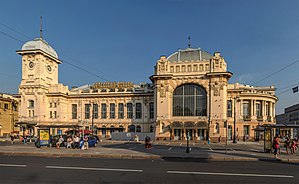Vitebsky Rail Terminal
|
St Petersburg-Vitebsky
|
|
|---|---|
|
|
|

Vitebsk Railway Station in July 2014
|
|
| Location | 52, Zagorodny av., St. Petersburg, Russia |
| Coordinates | 59°55′12″N 30°19′44″E / 59.9199°N 30.3289°ECoordinates: 59°55′12″N 30°19′44″E / 59.9199°N 30.3289°E |
| Platforms | 5 (3 island platforms) |
| Tracks | 8 |
| Connections |
Saint Petersburg Metro stations: |
| Construction | |
| Structure type | elevated |
| Platform levels | 2 |
| Parking | yes |
| Other information | |
| Station code | 033061 |
| Fare zone | 0 |
| History | |
| Opened | 1837 |
| Rebuilt | 1852, 1904 |
| Electrified | 1953 |
| Previous names | Tsarskoselsky, Detskoselsky |
Saint Petersburg Metro stations:![]() Pushkinskaya
Pushkinskaya
St Petersburg-Vitebsky (Russian: Ви́тебский вокза́л) is a railway station in Saint Petersburg, Russia. Formerly known as St Petersburg-Tsarskoselsky station, it was the first railway station to be built in Saint Petersburg and the whole of the Russian Empire.
The station, located at the crossing of the Zagorodny Avenue and the now-vanished Vvedensky Canal, was inaugurated in the presence of Nicholas I of Russia on 30 October 1837 when the first Russian train, named Provorny, departed from its platform for the imperial residence at Tsarskoe Selo. A replica of this train may be seen as a permanent exhibit at the modern station.
The first building of the Petersburg Station (as it was then known) was constructed in timber in August and September of the same year to a design by Konstantin Thon. Since it proved to be too small, it was demolished within twelve years and a much larger structure was erected under Thon's supervision between 1849 and 1852. There were further expansions in the 1870s.
The station became increasingly ramshackle and cluttered as the 19th century went on, until the decision was taken to tear the whole thing down and begin again. Construction started in 1901 and lasted for three years. Stanislaw Brzozowski gave the new two-storey station an ornate frontage in an assortment of historical styles, with decorative reliefs, floriated Jugendstil detailing, outsize semicircular windows and two regular features of 19th-century train stations: a pseudo-Renaissance cupola and a square clocktower.
...
Wikipedia
